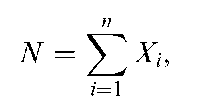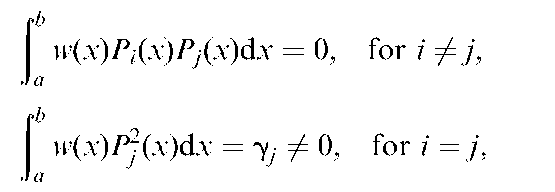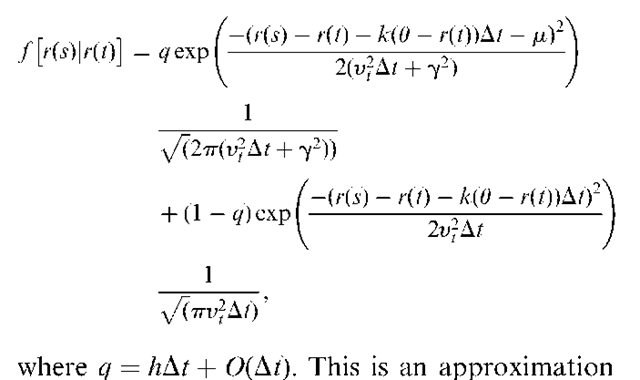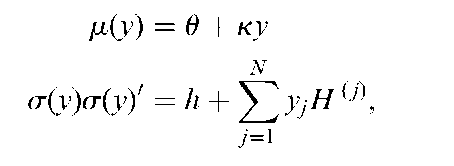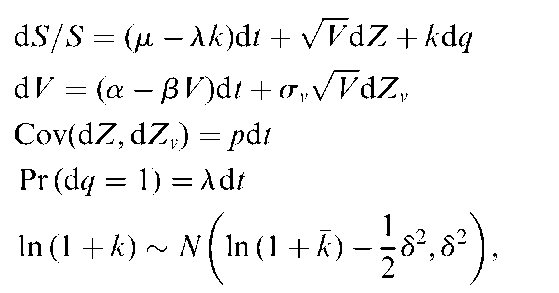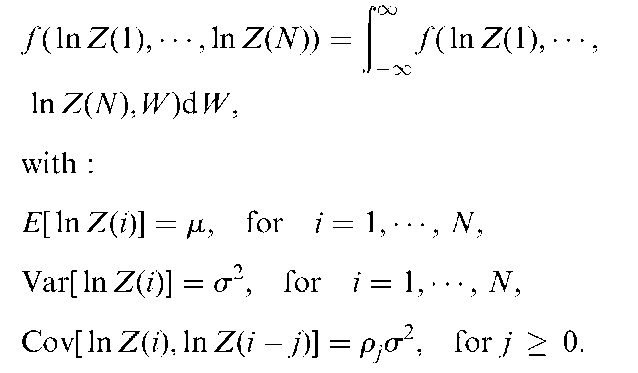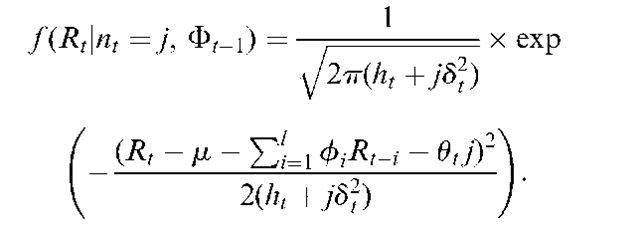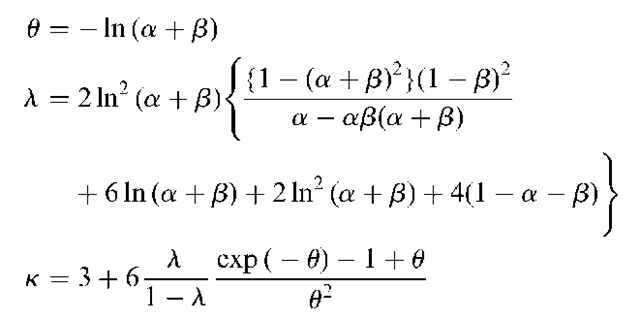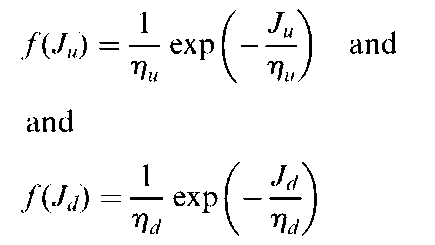Abstract
Jump diffusion processes have been used in modern finance to capture discontinuous behavior in asset pricing. Various jump diffusion models are considered in this chapter. Also, the applications of jump diffusion processes on stocks, bonds, and interest rate are discussed.
Keywords: Black-Scholes model; jump diffusion process; mixed-jump process; Bernoulli jump process; Gauss-Hermite jump process; conditional jump dynamics; ARCH/GARCH jump diffusion model; affine jump diffusion model; autoregressive jump process model; jump diffusion with conditional heteroskedasticity.
Introduction
In contrast to basic insights into continuous-time asset-pricing models that have been driven by stochastic diffusion processes with continuous sample paths, jump diffusion processes have been used in finance to capture discontinuous behavior in asset pricing. As described in Merton (1976), the validity of Black-Scholes formula depends on whether the stock price dynamics can be described by a continuous-time diffusion process whose sample path is continuous with probability 1. Thus, if the stock price dynamics cannot be represented by stochastic process with a continuous sample path, the Black-Scholes solution is not valid. In other words, as the price processes feature big jumps, i.e. not continuous, continuous-time models cannot explain why the jumps occur, and hence not adequate. In addition, Ahn and Thompson (1986) also examined the effect of regulatory risks on the valuation of public utilities and found that those ”jump risks” were priced even though they were uncorrelated with market factors. It shows that jump risks cannot be ignored in the pricing of assets. Thus, a ”jump” stochastic process defined in continuous time, and also called as ”jump diffusion model” was rapidly developed.
The jump diffusion process is based on Poisson process, which can be used for modeling systematic jumps caused by surprise effect. Suppose we observe a stochastic process St, which satisfies the following stochastic differential equation with jump:
where d Wt is a standard Wiener process. The term dJt represents possible unanticipated jumps, and which is a Poisson process. As defined in Gourier-oux and Jasiak (2001), a jump process (Jt,t 2 R+) is an increasing process such that
where o(dt) tends to 0 when t tends to 0, and At, called the intensity, is a function of the information available at time t. Furthermore, since the term dJt is part of the unpredictable innovation terms we make E[AJt] = 0, which has zero mean during a finite interval h. Besides, as any predictable part of the jumps may be can be included in the drift component at, jump times tj, j = 1, 2,____ vary by some discrete and random amount. Without loss of generality, we assume that there are k possible types of jumps, with size ai, i = 1, 2, L, and the jumps occur at rate At that may depend on the latest observed St. As soon as a jump occurs, the jump type is selected randomly and independently. The probability of a jump of size ai, occuring is given by pi. Particularly, for the case of the standard Poisson process, all jumps have size 1. In short, the path of a jump process is an increasing stepwise function with jumps equal to 1 at random rate A, D2,…, Dt,…,.
Related research on the earlier development of a basic Poisson jump model in finance was by Press (1967). His model can be motivated as the aggregation of a number of price changes within a fixed-time interval. In his paper, the Poisson distribution governs the number of events that result in price movement, and the average number of events in a time interval is called intensity. In addition, he assumes that all volatility dynamics is the result of discrete jumps in stock returns and the size of a jump is stochastic and normally distributed. Consequently, some empirical applications found that a normal Poisson jump model provides a good statistical characterization of daily exchange rate and stock returns. For instance, using Standard & Poor’s 500 futures options and assuming an underlying jump diffusion, Bates (1991) found systematic behavior in expected jumps before the 1987 stock market crash. In practice, by observing different paths of asset prices with respect to different assets, distinct jump diffusion models were introduced into literature by many researchers. Therefore, in this chapter, we will survey various jump diffusion models in current literature as well as estimation procedures for these processes.
Mixed-Jump Processes
The total change in asset prices may be comprised of two types of changes:
1. Normal vibrations caused by marginal information events satisfying a local Markov property and modeled by a standard geometric Brownian motion with a constant variance per unit time. It has a continuous sample path.
2. Abnormal vibrations caused by information shocks satisfying an antipathetical jump process defined in continuous time, and modeled by a jump process, reflecting the nonmarginal impact of the information.
Thus, there have been a variety of studies that explain too many outliers for a simple, constant-variance log-normal distribution of stock price series. Among them, Merton (1976) and Tucker and Pond (1988) provide a more thorough discussion of mixed-jump processes. Mixed-jump processes are formed by combining a continuous diffusion process and a discrete-jump process and may capture local and nonlocal asset price dynamics.
Merton (1976) pioneered the use of jump processes in continuous-time finance. He derived an option pricing formula as the underlying stock returns are generated by a mixture of both continuous and the jump processes. He posited stock returns as
where S is the stock price, a the instantaneous expected return on the stock, s2 the instantaneous variance of the stock return conditional on no arrivals of “abnormal” information, dZ the standardized Wiener process, q the Poisson process assumed independent of dZ, l the intensity of the Poisson process, k = «(Y — 1), where Y — 1 is the random variable percentage change in stock price if the Poisson event occurs; « is the expectation operator over the random variable Y. Actually, Equation (43.1) can be rewritten as
Therefore, the option return dynamics can be rewritten as
Most likely, aw is the instantaneous expected return on the option, s2v is the instantaneous variance of the stock return conditional on no arrivals of “abnormal” information, qw is an Poisson process with parameter l assumed independent of dZ, kw = s(Yw — 1), (Yw — 1) is the random variable percentage change in option price if the Poisson event occurs, «is the expectation operator over the random variable Yw. The Poisson event for the option price occurs if and only if the Poisson event for the stock price occurs. Further, define the random variable, Xn, which has the same distribution as the product of n independently and identically distributed random variables. Each of n independently and identically distributed random variables has the identical distribution as the random variable Y described in Equation (43.1). As a consequence, by the original Black-Scholes option pricing formula for the no-jump case, W(S, t; E, r, s2), we can get the option price with jump component
Generally speaking, W satisfies the boundary conditions of partial differential equation (see Oksen-dal, 2000), and can be rewritten as a twice continuously differentiable function of the stock price and time, W(t) = F(S, t). Nevertheless, Equation (43.4) still not only holds most of the attractive features of the original Black-Scholes formula such as being regardless of the investor preferences or knowledge of the expected return on the underlying stock, but also satisfies the Sharpe-Linter Capital Asset Pricing model as long as the jump component of a security’s return is uncorrelated with the market. In other words, the mixed-jump model of Merton uses the CAPM to value options written on securities involving jump processes.
Also, Tucker and Pond (1988) empirically investigated four candidate processes (the scaled-1 distribution, the general stable distribution, compound normal distribution, and the mixed-jump model) for characterizing daily exchange rate changes for six major trading currencies from the period 1980 to 1984. They found that the mixed-jump model exhibited the best distributional fit for all six currencies tested. Akgiray and Booth (1988) also found that the mixed-diffusion jump process was superior to the stable laws or mixture of normals as a model of exchange rate changes for the British pound, French franc, and the West German mark relative to the U.S. dollar. Thus, both theoretical and empirical studies of exchange rate theories under uncertainty should explicitly allow for the presence of discontinuities in exchange rate processes. In addition, the assumption of pure diffusion processes for exchange rates could lead to misleading inferences due to its crude approximation.
Bernoulli Jump Process
In the implementation of empirical works, Ball and Torous (1983) provide statistical evidence with the existence of log-normally distributed jumps in a majority of the daily returns of a sample of NYSE-listed common stocks. The expression of their Poisson jump diffusion model is as Equation (43.1), and jump size Yhas posited distribution, ln Y ~ N(m, d2).
Ball and Torous (1983) introduced the Bernoulli jump process as an appropriate model for stock price jumps. Denote X as the number of events that occur in subinterval i and independent distributed random variables. By stationary independent increment assumption,
where N is the number of events that occur in a time interval of length t. Besides, define h = t/n for any arbitrary integer n and divide (0, t) into n equal subintervals each of length h. Thus, Xi satisfies
For large n, Xi has approximately the Bernoulli distribution with parameter Ah = A t/n. As a result, N has the binomial distribution, approximately, i.e.
Now, assume that t is very small, they can approximate N by the Bernoulli variate X defined by
The advantage of the Bernoulli jump process is that more satisfactory empirical analyses are available. The maximum likelihood estimation can be practically implemented and the unbiased, consistent, and efficient estimators that attain the Cramer-Rao lower bound for the corresponding parameters. Moreover, the statistically most powerful test of the null hypothesis A = 0 can be implemented. Obviously, a Bernoulli jump process models information arrivals and stock price jumps. This shows that the presence of a jump component in common stock returns can be possessed well. As a consequence, Vlaar and Palm (1993) combined the GARCH (1,1) and Bernoulli jump distribution to account for skewness and leptokurtosis for weekly rates of the European Monetary System (EMS). Das (2002) considered the concept of Bernoulli approximation to test the impact of Federal Reserve actions by Federal Funds’ rate as well. (See Section 43.9.2 and Section 43.5, respectively.)
Gauss-Hermite Jump Process
To ensure the efficiency properties in valuing compound option, Omberg (1988) derived a family of jump models by employing Gauss-Hermite quadrature.
of the compound option at time tk, the current value of the compound option is then CN(S); the value of an actual contingent claim with optimal exercise possible at any time is lim N ^ CN(S). The compound option can be recursively valued by
where EVk+1 is the immediate exercise value at time tk+1. Since S(t) is an unrestricted log-normal diffusion process from tk to tk+1,
where z is an independent sample from a normal distribution with mean zero and variance one, f (z) is its density function, and m’ = r — s2/2 for a risk-neutral valuation. A jump process approximation to the above with n jumps takes the form
So, Omberg (1988) considers to use Gaussian integration to approximate an intergral of the form as in Equation (43.5). For example, for the intergral,
we can approximate this equation by a weighted average of the function f(x) at n points {x1, …, xn}. Let {wi} and {xj} are selected to maximize the degree of precision m*, which is a integration rule, i.e. if the integration error is zero for all polynomialsf(x) of order m* or less. {Pj(x)} is the set of polynomials with respect to the weighting function w(x),
Thus, the optimal evaluation points {Xj} are the n zeros of Pn(x) and the corresponding weights {wj} are
The degree of precision is m* = 2n — 1. If the weighting function w(x) is symmetric with regard to the midpoint of the interval [a, b], then {xj} and {wj} are the Gaussian evaluation points {xj} and weights {wj}, respectively. Particularly, the above procedure is called Gauss-Hermite quadrature to approximate the integration problem. What is shown in Omberg (1988) is the application of Gauss-Hermite quadrature to the valuation of a compound option, which is a natural way to generate jump processes of any order n that are efficient in option valuation. Thus, the Gauss-Her-mite jump process arises as an efficient solution to the problem of replicating a contingent claim over a finite period of time with a portfolio of assets. With this result, he suggested the extension of these methods to option valuation problems with multiple state variables, such as the valuation of bond options in which the state variables are taken to be interest rates at various terms.
Jumps in Interest Rates
Cox et al. (1985a) proposed an influential paper that derived a general equilibrium asset pricing model under the assumption of diffusion processes, and analyzed the term structure of interest rate by it. Ahn and Thompson (1988) applied Cox, Ingersoll, and Ross’s methodology to their model, which is driven by jump diffusion processes, and investigated the effect of jump components of the underlying processes on the term structure of interest rates. They differ from the model of Cox et al. (1985) when they consider the state variables as jump diffusion processes. Therefore, they suggested that jump risks may have important implications for interest rate, and cannot be ignored for the pricing of assets. In other words, they found that Merton’s multi-beta CAPM does not hold in general due to the existence of jump component of the underlying processes on the term structure of interest rate. Also, Breeden’s single consumption beta does not hold, because the discontinuous movements of the investment opportunities cannot be fully captured by a single consumption beta. Moreover, in contrast with the work of Cox et al. (1981) providing that the traditional expectations theory is not consistent with the equilibrium models, they found that traditional expectations theory is not consistent with the equilibrium models as the term structure of interest rate is under the jump diffusion process, since the term premium is affected by the jump risk premiums. Das (2002) tested the impact of Federal Reserve actions by examining the role of jump-enhanced stochastic processes in modeling the Federal Funds rate. This research illustrated that compared to the stochastic processes of equities and foreign exchange rates, the analytics for interest rates are more complicated. One source of analytical complexity considered in modeling interest rates with jumps is mean reversion. Allowing for mean reversion included in jump diffusion processes, the process for interest rates employed in that paper is as follows
which shows interest rate has mean-reversing drift and two random terms, a pure diffusion process and a Poisson process with a random jump J. In addition, the variance of the diffusion is y2, and a Poisson process p represents the arrival of jumps with arrival frequency parameter h, which is defined as the number of jumps per year. Moreover, denote J as jump size, which can be a constant or with a probability distribution. The diffusion and Poisson processes are independent of each other as well as independent of J.
The estimation method used here is the Bernoulli approximation proposed in Ball and Torous (1983). Assuming that there exists no jump or only one jump in each time interval, approximate the likelihood function for the Poisson-Gauss model using a Bernoulli mixture of the normal distributions governing the diffusion and jump shocks.
In discrete time, Equation (43.6) can be expressed as follows:
where y2 is the annualized variance of the Gaussian shock, and Dz is a standard normal shock term. J(m, g2) is the jump shock with normal distribution. Dp(q) is the discrete-time Poisson increment, approximated by a Bernoulli distribution with parameter q = hDt + O(Dt), allowing the jump intensity q to depend on various state variables conditionally. The transition probabilities for interest rates following a Poisson-Gaussian process are written as (for s > t):
for the true Poisson-Gaussian density with a mixture of normal distributions. As in Ball and Torous (1983), by maximum-likelihood estimation, which maximizes the following function L,
we can obtain estimates that are consistent, unbiased, and efficient and attain the Cramer-Rao lower bound. Thus, they obtain the evidence that jumps are an essential component of interest rate models. Especially, the addition of a jump process diminishes the extent of nonlinearity although some research finds that the drift term in the stochastic process for interest rates appears to be nonlinear.
Johannes (2003) suggested the estimated infinitesimal conditional moments to examine the statistical and economic role of jumps in continuous-time interest rate models. Based on Johannes’s approach, Bandi and Nguyen (2003) provided a general asymptotic theory for the full function estimates of the infinitesimal moments of continuous-time models with discontinuous sample paths of the jump diffusion type. Their framework justifies consistent nonparametric extraction of the parameters and functions that drive the dynamic evolution of the process of interest. (i.e. the potentially nonaffine and level dependent intensity of the jump arrival being an example). Particularly, Singleton (2001) provided characteristic function approaches to deal with the Affine jump diffusion models of interest rate. In the next section, we will introduce affine jump diffusion model.
Affine Jump Diffusion model
For development in dynamic asset pricing models, a particular assumption is that the state vector X follows an affine jump diffusion (AJD). An affine jump model is a jump diffusion process. In general, as defined in Duffie and Kan (1996), we suppose the diffusion for a Markov process X is ‘affine’ if
where m: D ! Rn and s: D ! Rnxn, U is N x 1, k is N x N, h and H(j) are all N x N and symmetric. The X’s may represent observed asset returns or prices or unobserved state variables in a dynamic pricing model, such as affine term structure models. Thus, extending the concept of ‘affine’ to the case of affine jump diffusions, we can note
that the properties for affine jump diffusions are that the drift vector, “instantaneous” covar-iance matrix, and jump intensities all have affine dependence on the state vector. Vasicek (1977) and Cox et al. (1985) proposed the Gaussian and square root diffusion models which are among the AJD models in term structure literature. Suppose that X is a Markov process in some state space D c Rn, the affine jump diffusion is
Furthermore, in Duffie et al. (2000), they suppose that X is Markov process whose transition semi-group has an infinitesimal generator of levy type defined at a bounded C2 function f: D ^ R with bounded first and second derives by
It means that conditional on the path of X, the jump times of Z are the jump times of a Poisson process with time varying intensity {1(Xs): 0 < s < t}, and that the size of the jump of Z at a jump time T is independent of {Xs : 0 < s < T}, and has the probability distribution y. Consequently, they provide an analytical treatment of a class of transforms, including Laplace and Fourier transformations in the setting of affine jump diffusion state process.
The first step to their method is to show that the Fourier transform of Xt and of certain related random variables are known in closed form. Next, by inverting this transform, they show how the distribution of Xt and the prices of options can be recovered. Then, they fix an affine discount rate function R: D ^ R. Depending on coefficients (K, H, L, p), the affine dependence of m, ssT, l, R are determined, as shown in p.1350 of Duffie et al. (2000). Moreover, for c 2 Cn, the set of n-tuples of complex numbers, let 0(c) = JRn exp(c.z)dv(z).
Thus, the “jump transform” U determines the jump size distribution. In other words, the “coefficients” (K, H, l, U) of X completely determine its distribution. Their method suggests a real advantage of choosing a jump distribution v with an explicitly known or easily computed jump transform U. They also applied their transform analysis to the pricing of options. See Duffle et al. (2000). Furthermore, Singleton (2001) developed several estimation strategies for affine asset pricing models based on the known functional form of the conditional characteristic function (CCF) of discretely sampled observations from an affine jump diffusion model, such as LML-CCF (Limited-information estimation), ML-CCF (Maximum likelihood estimation), and GMM-CCF estimation, etc. As shown in his paper, a method of moments estimator based on the CCF is shown to approximate the efficiency of maximum likelihood for affine diffusion models.
Geometric Jump Diffusion Model
Using Geometric Jump Diffusion with the instantaneous conditional variance, Vt, following a mean reverting square root process, Bates (1996) showed that the exchange rate, S($/deutschemark(DM)) followed it:
where m is the instantaneous expected rate of appreciation of the foreign currency, l is the numbers of jumps in a year, k is the random percentage jump conditional on a jump occurring, and q is a Poisson counter with intensity l.
The main idea of this model illustrated that skewed distribution can arise by considering nonzero average jumps. Similarly, it also discusses that excess kurtosis can arise from a substantial jump component. In addition, this geometric jump diffusion model can see a direct relationship between the magnitude of conditional skewness and excess kurtosis and the length of the holding period as well.
Autoregressive Jump Process Model
A theory of the distribution of stock returns was derived by Bachelier (1900) and expanded using the idea of Brownian motion by Osborne (1959). However, the empirical works generally concluded that the B-O model fits observed returns rather poorly. For example, a casual examination of transactions data shows that assumption of a constant interval between transactions is not strictly valid. On the other hand, transactions for a given stock occur at random times throughout a day which gives nonuniform time intervals Also, the notion of independence between transaction returns is suspect. Niederhoffer and Osborne (1966) showed that the empirical tests of independence using returns based on transaction data have generally found large and statistically significant negative correlation. Thus, it is reasonable to model returns as a process with random time intervals between transaction and serial correlation among returns on individual trades. Accordingly, an auto-regressive jump process that models common stock returns through time was proposed by Oldfield et al. (1977). This model consists of a diffusion process, which is continuous with probability 1 and jump processes, which are continuous with probability 1. The jump process is assumed to operate such that a jump occurs at each actual transaction, and allows the magnitudes of jumps to be auto-correlated. In addition, the model relies on the distribution of random time intervals between transactions. They suppose the dollar return of a common stock over a holding period of length s is the result of a process, which is a mixture process composed of a continuous and jump process,
where P stands for share price, dW is the increment of a Wiener process with zero mean and unit variance, z is the percent change in share price resulting from a jump, dp is a jump process (when dp = 1, a jump occurs; when dp = 0, no jump occurs) and dp and dW are assumed to be independent. Jump amplitude is independent of dp and d W, but jumps may be serially correlated. s is the elapsed time between observed price Pt+s and Pt. The number of jumps during the interval s is N, and Z(i) are the jump size where Z(0) = 1 and Z(i) > 0 for i = 1, …, N. And the solution for Equation (43.7) is
Divide Equation (43.8) by P(t) and take natural logarithms, then
According to the Equation (43.9), we can see the third term of Equation (43.9) is the jump process. If N = 0 then ln [P(t + s)/P(s)] is normally distributed with mean (a — b2/2)s and variance b2s. If the ln Z(i) are assumed to be identically distributed with mean m and finite variance s2, a general form of joint density for ln Z(i) can be represented by:
where py is the correlation between lnZ(i) and ln Z(i — j). The index i represents the jump number while the index j denotes the number of lags between jumps. The startling feature of this general joint density is the autocorrelation among jumps. Hence, some major conclusions are drawn from the data analysis: (1).
A geometric Brownian motion process or a subordinated process does not alone describe the sample data very well. (2). Stock returns seem to follow an autoregressive jump process based on the sample means and variances of transaction returns. (3). In contrast to the previous empirical work which is not sufficiently detailed to determine the probability law for transaction returns, the probability density for the time intervals between jumps is gamma.
Jump Diffusion Models with Conditional Heteroscedasticity
Conditional Jump Dynamics
The basic jump model has been extended in a number of directions. A tractable alternative is to combine jumps with an ARCH/GARCH model in discrete time. It seems likely that the jump probability will change over time. Ho et al. (1996) formulate a continuous-time asset pricing model based on the work of Chamnerlain (1988), but include jumps. Their work strongly suggested that both jump components and heteroscedastic Brownian motions are needed to model the asset returns. As the jump components are omitted, the estimated rate of convergence of volatility to its unconditional mean is significantly biased. Moreover, Chan and Maheu (2002) developed a new conditional jump model to study jump dynamics in stock market returns. They present a discrete-time jump model with time varying conditional jump intensity and jump size distribution. Besides, they combine the jump specification with a GARCH parameterization of volatility. Consider the following jump model for stock returns:
Define the information set at time t to be the history of returns, Ft = {Rt, ,R1} The conditional jump size Yt,k, given $t_i, is presumed to be independent and normally distributed with mean Ut and variance d2. Denote nt as the discrete counting process governing the number of jumps that arrive between t — 1 and t, which is distributed as a Poisson random variable with the parameter At > 0 and density
The mean and variance for the Poisson random variable are both At, which is often called the jump intensity. The jump intensity is allowed time-varying. ht is measurable with respect to the information set Ft—1 and follows a GARCH(p,q) process,
where st = Rt — m — Ym= 1 fiRt—i. «t contains the expected jump component and it affects future volatility through the GARCH variance factor. Moreover, based on a parsimonious ARMA structure, let At be endogenous. Denote the following ARJI(r,s) model:
At = E[nt\Ft—1] is the conditional expectation of the counting process. jt—i represents the innovation to At—i. The shock jump intensity residual is
The first term of Equation (43.12) is average number of jumps at time t — i based on time t — i information. Therefore, xit—i represents the unpredictable component about the conditional mean of the counting process nt—i. Moreover, having observed Rt, let f (Rt\nt = j, denote the conditional density of returns given that j jumps occur and the information set 1, we can get the ex-post probability of the occurrence of j jumps at time t, with the filter defined as
where, the definition of P(nt = j\$t-1) is the same as Equation (43.11). The filter in Equation (43.13) is an important component of their model of time varying jump dynamics. Thus, the conditional density of return is
Equation (43.14) shows that this model is nothing more than a discrete mixture of distribution where the mixing is driven by a time varying Poisson distribution. Therefore, from the assumption of Equation (43.10), the distribution of returns conditional on the most recent information set and j jumps is normally distributed as
Equation (43.13) includes an infinite sum over the possible number of jumps nt. However, practically, they consider truncating the maximum number of jumps to a large value t, and then they set the probability of t or more jumps to 0. Hence, the first way to choose t is to check Equation (43.11) to be equal to 0 for j > t. The second check on the choice of t is to investigate t > t to make sure that the parameter estimate does not change.
The ARJI model illustrates that conditional jump intensity is time varying. Suppose that we observe jt > 0 for several periods. This suggests that the jump intensity is temporarily trending away from its unconditional mean. On the other hand, this model effectively captures systematic changes in jump risk in the market. In addition, they find significant time variation in the conditional jump intensity and the jump size distribution in their application for daily stock market returns. Accordingly, the ARJI model can capture systematic changes, and also forecast increases (decreases) in jump risk into the future.
ARCH/GARCH Jump Diffusion Model
As described in Drost et al. (1998), there exists a major drawback of Merton’s (1976) model which implies that returns are independent and identically distributed at all frequencies that conflict with the overwhelming evidence of conditional heteroscedasticity in returns at high frequencies, because all deviations from log normality of observed stock returns at any frequency can be attributed to the jumps in his model. Thus, several papers consider the size of jumps within the models that also involve the conditional heteroscedasticity.
Jorion (1988) considered a tractable specification combining both ARCH and jump processes for foreign exchange market:
in which a1 is the autoregressive parameter inducing heteroskedasticity and the distribution of xt is conditional on information at t — 1 and define xt as the logarithm of price relative ln(Pt/Pt—1). A jump size Y is assumed independently log normally distributed, ln Y ~ N(U, d2), nt is the actual number of jumps during the interval. z is a standard normal deviate. Consequently, his results reveal that exchange rate exhibit systematic discontinuities even after allowing for conditional hetero-skedasticity in the diffusion process. In brief, in his work, the maximum likelihood estimation of a mixed-jump diffusion process indicates that ignoring the jump component in exchange rates can lead to serious mispricing errors for currency options. The same findings also can be found in Nieuwland et al. (1991) who allow for the model with conditional heteroscedasticity and jumps in exchangerate market. Also, an application of a GARCH jump mixture model has been given by Vlaar and Palm (1993). They point out that the GARCH specification cum normal innovation cannot fully explain the leptokurtic behavior for high-frequency financial data. Both the GARCH specification and the jump process can explain the leptokurtic behavior. Hence, they permit autocorrelation in the mean higher-order GARCH effect and Bernoulli jumps.
A weak GARCH model can be defined as a symmetric discrete-time process {yh)t, t 2 h A} with finite fourth moment and with parameter Zh = (f h, ah, bh, kh), if there exists a covariance-stationary process {s(h)t, t2ha} with
Roughly speaking, the class of continuous-time GARCH models can be divided into two groups. One is the GARCH diffusion in which the sample paths are smooth and the other, where the sample paths are erratic. Drost and Werker (1996) developed several properties of discrete-time data that are generated by underlying continuous-time processes that accommodate both conditional hetero-scedasticity and jumps. Their model is as follows. Let {Yt, t > 0} be the GARCH jump diffusion with parameter vector Zh = (f h, ah, bh, kh) and suppose ah0 for some h0 > 0. Then, there exists v 2 (0, i), U 2 (0, i), f 2 (0, i), v 2 (0, i) and ch and kh are given by
where U is the time unit and scale is denoted by v. f and v are slope parameters and f will denote slopes in the (ah . bh) plane, while v determines the slope of the kurtosis at very high frequencies. Drost et al. (1998) employed the results of Drost and Werker (1996), which stated that for GARCH diffusion at an arbitrary frequency h, the five discrete-time GARCH parameters can be written in terms of only four continuous-time parameters, i.e an over identifying restriction in GARCH diffusion, for proposing a test for the presence of jumps with conditional heteroscedasticity, which is based on the following Theorem 1.
Theorem 1. Let {Yt: t > 0} be a continuous-time GARCH diffusion. Then U > 0 and l 2 (0,1) is defined by
Thus, we set up the null and alternative hypotheses:
H0: {Yt: t > 0} is a GARCH diffusion model and H1: {Yt: t > 0} is a GARCH jump diffusion model.
From Theorem 1, by simple calculation, we yield the relation between functions K and k: K(a, b, k) = k – k(a, b) = 0 for GARCH diffusion. Furthermore, in Drost and Werker (1996), they showed that K(a, b, k) will be strictly larger than 0 for any GARCH jump diffusion model. As a result, H0 is equivalent to K(a, b, k) = 0 and H1 is equivalent to K(a, b, k) > 0. In other words, this test can be viewed as the kurtosis test for presence of jumps with conditional heteroscedasticity. As well, it indicates the presence of jumps in dollar exchange rate.
Other Jump Diffusion models
As shown in Chacko and Viceira (2003), the jump diffusion process for stock price dynamics with asymmetric upward and downward jumps is
[exp(/„) - 1]dN„(A„) and [exp( - Jd) - 1]dNd(Ad) represent a positive jump and a downward jump, respectively. Ju, Jd > 0 are stochastic jump magnitudes, which implies that the stock prices are non-negative, Ad, Au > 0 are constant, and also determine jump frequencies. Furthermore, the densities of jump magnitudes, are drawn from exponential distributions. Note that m and -s are constants.
To estimate this process, they provide a simple, consistent procedure – spectral GMM by deriving the conditional characteristic function of that process.






